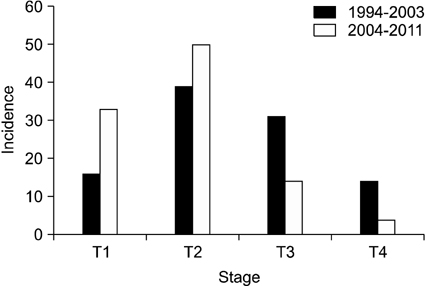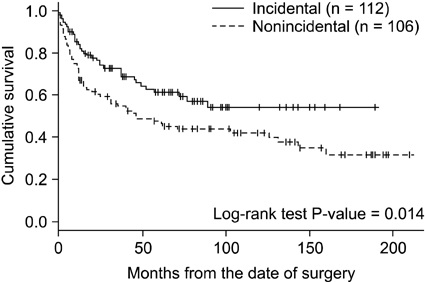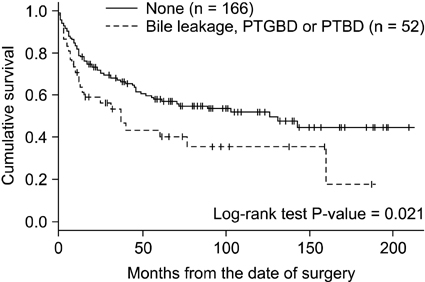J Korean Surg Soc.
2012 Oct;83(4):227-236. 10.4174/jkss.2012.83.4.227.
Prognostic factors for gallbladder cancer in the laparoscopy era
- Affiliations
-
- 1Department of Surgery, Dong-A University College of Medicine, Busan, Korea. yhkim1@dau.ac.kr
- 2Department of Radiology, Dong-A University College of Medicine, Busan, Korea.
- 3Department of Internal Medicine, Dong-A University College of Medicine, Busan, Korea.
- 4Department of Pathology, Dong-A University College of Medicine, Busan, Korea.
- KMID: 2212311
- DOI: http://doi.org/10.4174/jkss.2012.83.4.227
Abstract
- PURPOSE
Hepatobiliary surgery has changed dramatically in recent decades with the advent of laparoscopic techniques. The aim of this retrospective study was to compare survival rates according to stages, adjusting for important prognostic factors.
METHODS
A retrospective study of a 17-year period from January 1994 to April 2011 was carried out. The cases studied were divided into two time period cohorts, those treated in the first 9-years (n = 109) and those treated in the last 7-years (n = 109).
RESULTS
An operation with curative intent was performed on 218 patients. The 5-year survival rates according to the depth of invasion were 86% (T1), 56% (T2), 45% (T3), and 5% (T4). The number of cases of incidental gallbladder cancer found during 3,919 laparoscopic cholecystectomies was 96 (2.4%). Incidental gallbladder cancer revealed a better survival rate (P = 0.003). Iatrogenic bile spillage was found in 20 perforations of the gallbladder during laparoscopic cholecystectomies, 16 preoperative percutaneous transhepatic gallbladder drainages and 16 percutaneous transhepatic biliary drainages; only percutaneous transhepatic biliary drainage patients showed a significantly lower survival rate than patients without iatrogenic bile spillage (P < 0.034). Chemoradiation appeared to improve overall survival (P < 0.001). Multivariate analysis also revealed that time period, type of surgery, surgical margin, lymphovascular invasion, lymph node involvement, and chemoradiation therapy had significant effects.
CONCLUSION
This study found that the prognosis of gallbladder cancer is still determined by the stage at presentation due to the aggressive biology of this tumor. Early diagnosis, radical resection and appropriate adjuvant therapy can increase overall survival.
Keyword
MeSH Terms
Figure
Cited by 1 articles
-
Comparison of outcomes of single incision robotic cholecystectomy and single incision laparoscopic cholecystectomy
Sun Min Lee, Jin Hong Lim
Ann Hepatobiliary Pancreat Surg. 2021;25(1):78-83. doi: 10.14701/ahbps.2021.25.1.78.
Reference
-
1. Konstantinidis IT, Deshpande V, Genevay M, Berger D, Fernandez-del Castillo C, Tanabe KK, et al. Trends in presentation and survival for gallbladder cancer during a period of more than 4 decades: a single-institution experience. Arch Surg. 2009. 144:441–447.2. Goetze T, Paolucci V. Does laparoscopy worsen the prognosis for incidental gallbladder cancer? Surg Endosc. 2006. 20:286–293.3. Shih SP, Schulick RD, Cameron JL, Lillemoe KD, Pitt HA, Choti MA, et al. Gallbladder cancer: the role of laparoscopy and radical resection. Ann Surg. 2007. 245:893–901.4. Yokomizo H, Yamane T, Hirata T, Hifumi M, Kawaguchi T, Fukuda S. Surgical treatment of pT2 gallbladder carcinoma: a reevaluation of the therapeutic effect of hepatectomy and extrahepatic bile duct resection based on the long-term outcome. Ann Surg Oncol. 2007. 14:1366–1373.5. Tanaka N, Nobori M, Suzuki Y. Does bile spillage during an operation present a risk for peritoneal metastasis in bile duct carcinoma? Surg Today. 1997. 27:1010–1014.6. D'Angelica M, Dalal KM, DeMatteo RP, Fong Y, Blumgart LH, Jarnagin WR. Analysis of the extent of resection for adenocarcinoma of the gallbladder. Ann Surg Oncol. 2009. 16:806–816.7. Goetze TO, Paolucci V. Adequate extent in radical re-resection of incidental gallbladder carcinoma: analysis of the German Registry. Surg Endosc. 2010. 24:2156–2164.8. Weiland ST, Mahvi DM, Niederhuber JE, Heisey DM, Chicks DS, Rikkers LF. Should suspected early gallbladder cancer be treated laparoscopically? J Gastrointest Surg. 2002. 6:50–56.9. Kondo S, Takada T, Miyazaki M, Miyakawa S, Tsukada K, Nagino M, et al. Guidelines for the management of biliary tract and ampullary carcinomas: surgical treatment. J Hepatobiliary Pancreat Surg. 2008. 15:41–54.10. Ouchi K, Mikuni J, Kakugawa Y. Organizing Committee, The 30th Annual Congress of the Japanese Society of Biliary Surgery. Laparoscopic cholecystectomy for gallbladder carcinoma: results of a Japanese survey of 498 patients. J Hepatobiliary Pancreat Surg. 2002. 9:256–260.11. Vollmer CM, Drebin JA, Middleton WD, Teefey SA, Linehan DC, Soper NJ, et al. Utility of staging laparoscopy in subsets of peripancreatic and biliary malignancies. Ann Surg. 2002. 235:1–7.12. Vollmer CM Jr. Unexpected identification of gallbladder carcinoma during cholecystectomy. J Gastrointest Surg. 2009. 13:2034–2036.13. Allemann P, Schafer M, Demartines N. Critical appraisal of single port access cholecystectomy. Br J Surg. 2010. 97:1476–1480.14. Sikora SS, Singh RK. Surgical strategies in patients with gallbladder cancer: nihilism to optimism. J Surg Oncol. 2006. 93:670–681.15. Lee BS, Kim DH, Chang YS, Kang JH, Lee TS, Han JG. Radical reresection for T2 gallbladder cancer patients diagnosed following laparoscopic cholecystectomy. J Korean Surg Soc. 2010. 78:398–404.16. Goetze TO, Paolucci V. Benefits of reoperation of T2 and more advanced incidental gallbladder carcinoma: analysis of the German registry. Ann Surg. 2008. 247:104–108.17. Wakai T, Shirai Y, Hatakeyama K. Radical second resection provides survival benefit for patients with T2 gallbladder carcinoma first discovered after laparoscopic cholecystectomy. World J Surg. 2002. 26:867–871.18. Toyonaga T, Chijiiwa K, Nakano K, Noshiro H, Yamaguchi K, Sada M, et al. Completion radical surgery after cholecystectomy for accidentally undiagnosed gallbladder carcinoma. World J Surg. 2003. 27:266–271.19. Fong Y, Jarnagin W, Blumgart LH. Gallbladder cancer: comparison of patients presenting initially for definitive operation with those presenting after prior noncurative intervention. Ann Surg. 2000. 232:557–569.20. Pawlik TM, Gleisner AL, Vigano L, Kooby DA, Bauer TW, Frilling A, et al. Incidence of finding residual disease for incidental gallbladder carcinoma: implications for re-resection. J Gastrointest Surg. 2007. 11:1478–1486.21. Belli G, Cioffi L, D'Agostino A, Limongelli P, Belli A, Russo G, et al. Revision surgery for incidentally detected early gallbladder cancer in laparoscopic era. J Laparoendosc Adv Surg Tech A. 2011. 21:531–534.22. Gumbs AA, Hoffman JP. Laparoscopic radical cholecystectomy and Roux-en-Y choledochojejunostomy for gallbladder cancer. Surg Endosc. 2010. 24:1766–1768.23. Cho JY, Han HS, Yoon YS, Ahn KS, Kim YH, Lee KH. Laparoscopic approach for suspected early-stage gallbladder carcinoma. Arch Surg. 2010. 145:128–133.24. Kayahara M, Nagakawa T. Recent trends of gallbladder cancer in Japan: an analysis of 4,770 patients. Cancer. 2007. 110:572–580.25. Yamaguchi R, Nagino M, Oda K, Kamiya J, Uesaka K, Nimura Y. Perineural invasion has a negative impact on survival of patients with gallbladder carcinoma. Br J Surg. 2002. 89:1130–1136.26. Sasaki E, Nagino M, Ebata T, Oda K, Arai T, Nishio H, et al. Immunohistochemically demonstrated lymph node micrometastasis and prognosis in patients with gallbladder carcinoma. Ann Surg. 2006. 244:99–105.27. Jensen EH, Abraham A, Jarosek S, Habermann EB, Al-Refaie WB, Vickers SA, et al. Lymph node evaluation is associated with improved survival after surgery for early stage gallbladder cancer. Surgery. 2009. 146:706–711.28. Negi SS, Singh A, Chaudhary A. Lymph nodal involvement as prognostic factor in gallbladder cancer: location, count or ratio? J Gastrointest Surg. 2011. 15:1017–1025.29. Andre T, Reyes-Vidal JM, Fartoux L, Ross P, Leslie M, Rosmorduc O, et al. Gemcitabine and oxaliplatin in advanced biliary tract carcinoma: a phase II study. Br J Cancer. 2008. 99:862–867.30. Gold DG, Miller RC, Haddock MG, Gunderson LL, Quevedo F, Donohue JH, et al. Adjuvant therapy for gallbladder carcinoma: the Mayo Clinic Experience. Int J Radiat Oncol Biol Phys. 2009. 75:150–155.
- Full Text Links
- Actions
-
Cited
- CITED
-
- Close
- Share
- Similar articles
-
- Cholelithiasis as a Risk Factor for Gallbladder Cancer
- Gallbladder neck cancer and perihilar cholangiocarcinoma - siblings, cousins or look alikes?
- Should the Extrahepatic Bile Duct be Resected for T2 Gallbladder Cancer?
- Peritoneoscopy in Primary Gallbladder Cancer
- Acute Cholecystitis Associated with Gallbladder Metastasis of Gastric Cancer






